Operation Flyhook
This article is a work-in-progress because it is incomplete and pending further input from an author. Note: The contents of this article are not considered canonical and may be inaccurate. Please comment on this article's talk page to share your input, comments and questions. |
| Operational Flyhook | |||||||
|---|---|---|---|---|---|---|---|
| Part of the Cronan Theatre | |||||||
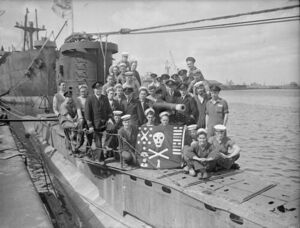 Arcer submariners preparing to conduct a patrol in the Polynesian Sea. | |||||||
| |||||||
| Belligerents | |||||||
|
|
| ||||||
| Commanders and leaders | |||||||
|
|
| ||||||
| Units involved | |||||||
| Royal Arcerion Submarine Service |
Capetian Navy Various Marine Merchantmen | ||||||
| Strength | |||||||
|
27 Submarines 6 Submarine Tenders Various Minelayers | Hundreds of surface vessels including escorts, merchantmen, and freighters | ||||||
| Casualties and losses | |||||||
|
| |||||||
The Small Cronan Sea War, officially Operation Flyhook or amongst Arcer submariners 'The Capetian Vacation,' was a period during the Second Great War during which Arcer submarines and their allies attacked Capetian merchant shipping and naval surface vessels along the Capetian Peninsula and in the Polynesian Sea. The engagement lasted the duration of the Second Great War, with several distinct phases occuring due to technological advancements or fluctuations in the course of the war's fighting.
The campaign lasted nine years, with the first engagements by Arcer submarines beginning just a few short weeks after the war's announcement, as it was part of Operation Forefront, the larger Arcer naval campaign in South Crona, the Songun and Polynesian Seas. Weak and disparate Capetian leadership early in the campaign meant that triple-digit losses were recorded of Capetian shipping with a number of notable surface vessels sunk.
Due to the lack of direct engagement by Arcer surface vessels against their Capetian counterparts, this portion of the conflict is considered the most dynamic and directly involved portion of the war on the naval side, as the Army and Air Force were embattled under Operation Lightfoot with their Paulastran allies.
Background
Prior to the outbreak of the war, shipping through the Polynesian Sea into the Songun Sea was a major trade route for maritime traffic and freighters heading into the Malentine Sea. While larger and more stable export economies such as Arcerion and Paulastra could rely on strong industry and agriculture, the more impoverished nations relied heavily on imported goods from Sarpedon and Levantia, meaning that the crucial naval route through the Eastern and Western Songun Straits, and then through the Warrington, were key economic terrain. While several attempts had been made to create economic protections or otherwise enforce some form of freedom of travel for both the Songun and Warrington Straits, ultimately the nations of South Crona were unable to come to a consensus on how to best implement a commercial and diplomatic strategy of cooperation prewar.
Geography
The Songun Straits are separated into two major waterways, the Eastern and Western, respectively. Between them and West of Cape Town is the Lower Songun Basin, which would see some of the most fiery convoy attacks and submarine actions during the Second Great War. North of this is the disputed Songun Sea. The Cape's islands in the Songun afforded it the geographical advantage in the Southeastern portions as it was able to more effectively conduct maritime patrols and anti-submarine patrols from airfields. However the geography and seafloor terrain of the Songun naturally pushed the Arcer submarines to the Western Songun, which was deeper and had more favorable currents and thermal layers.
The Warrington Strait was a secondary shipping lane although itself was the true key to central and Southern Crona, as it opened up into the Malentine Sea, a shallower and warmer body of water that six different sovereign nations (Arcerion, Telokona, Malentina, Kelekona, Porlos, and Istrenya) had maritime borders and extensive shipping and ports on. Due to this, Arcerion would fiercely defend the Warring Straits throughout the duration of the war, including the wo surface actions that took place under Operation Forefront.
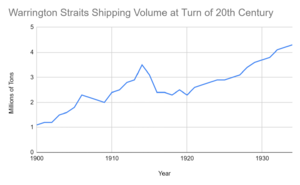
The Royal Arcerion Submarine Service Pre-War
The Arcer submarine service consisted of twenty-seven submarines, several submarine tenders and support vessels such as rearmament and refueling ships. Arcerion Naval HQ placed a high emphasis on the ability to rearm, refuel and repair submarines underway at sea away from a safe port-of-call, as the littoral nature of the Malentine and Songun Seas meant that maritime patrol aircraft and sabotage on port facilities could prevent the effective deployment of submarines during wartime. Research and development prior to the war had resulted in newer mine technologies, prototype snorkels, and improved rangefinding and electronic surveillance equipment allowing the service to be modern and ready for the conflict.
The drawbacks the service faced however, was an utter lack of real-world operational experience, owing to the dual nature of the service's relatively new nature (having only been in existence for 17 years) and the lack of an Arcer conventional conflict on the sea that would have allowed the service to effectively trial and test its doctrine, methods, and sailors. The service's rigorous standards of preparation and training however had created a culture of raiding and long-endurance patrolling that would benefit the disparate fleet. Arcerion had identified the difficulties of getting submarines into the Lower Songun Basin, and as such had provisioned plans to work with the Navy of Burrgundie to conduct at-sea underway replenishment of its submarines, giving them the ability to operate beyond the Songun and away from the most Southern Arcer naval facilities at Chester-on-Moore.
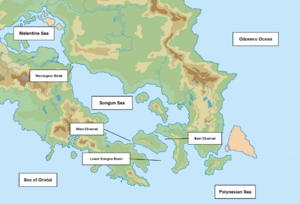
The Submarine Service was also complemented during Flyhook by a number of smaller minelayers, torpedo boats, and surface raiding vessels designed for the asymmetric nature of commerce raiding. Although doctrinally it was not a codified part of Arcer naval heritage or practice, the fleet would grow to accomodate this with the adoption of a class of light cruisers late-war that would participate to support the submarine force.
The leadership of Rear Admiral Lawrence Arthur Coxley, who was acting as Commander, Submarine Force, at the outbreak of the war would also prove pivotal as the emphasis on submerged operations (as most submarines of the period sailed on the surface) as well as the principles of mission command and reduced reliance on regular High-Frequency (HF) communications ensured that the Arcer submarine forces could remain at sea longer and patrol greater distances regardless of the logistical strain it was incurring at home.
**REPLACE WITH GRAPHIC ORG CHART**
Arcerion order of Battle
Royal Arcerion Submarine Service, Rear Admiral Lawrence Arthur Coxley (His Majesty's Arcer Naval Station Chester-on-Moore, Arcerion)
- Submarine Group 1
- Submarine Squadron 1
- HMAS David
- HMAS Integrity
- HMAS Castle
- HMAS Halberd
- HMAS Speedy
- HMAS Loyal
- Submarine Squadron 2
- HMAS Opal
- HMAS Redoubt
- HMAS Superior
- HMAS August
- Submarine Squadron 5
- HMAS Granite
- HMAS Onyx
- HMAS Osprey
- HMAS Powerful
- Submarine Squadron 1
- Submarine Group 2
- Submarine Squadron 3
- HMAS Dredge
- HMAS Sapphire
- HMAS Fortitude
- HMAS Dart
- HMAS Bluefin
- HMAS Banshee
- HMAS Innis
- Submarine Squadron 4
- HMAS MacCallan
- HMAS Typhoon
- HMAS Chester
- HMAS Arthur
- HMAS Reckoning
- HMAS Forthright
- Submarine Squadron 3
- Submarine Tender Squadron 5 (Oiler and Supply)
- HMAS Pearl
- HMAS Diligent
- HMAS Mermaid
- HMAS Unison
- HMAS Assurance
- HMAS Merchant
-TBD-
-Not great though-
Campaign
With the outbreak of the war, the commander of the submarine force, Rear Admiral Coxley, was recalled to the National Defense Headquarters in Kurst, along with his staff to brief the Arcer Admiralty on the readiness of the submarine force for war. The initial plans he briefed were the establishment of 5 'Special Raiding Zones,' numbered one to five. He intended to use his five submarine squadrons, organized into two Submarine Groups, to bring Capetian commercial shipping and maritime traffic to a halt. The admiralty approved the plan, giving him provisional instruction to begin at once.
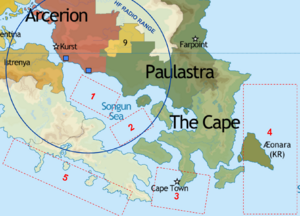
Early War (1934-1938)
The early war was defined by most Arcer submariners as the "Good time," when Capetian escort and anti-submarine vessels were either vacant, inept, or outmatched by the wit and aggression of their Arcer counterparts. Coxley assigned Submarine Group One with fourteen submarines to operate in zones 1-3, and their counterparts with thirteen submarines in Group Two as the Orixtal-Polynesian-Odoneru Force. Coxley's assertion was that by allowing one group to focus on the Sognun and the other far, in the blue water regions beyond the Lower Songun Basin, that they could develop their own tactics, training, and procedures to create a standard pattern for raiding that could be quickly disseminated to allow for more seamless integration of new submariners.
Coxley's major concern was the resupply of Submarine Group 2, as they were far afield from the ability for the six submarine tenders to resupply. Coxley sent a letter to the admiralty to engage with the Burgoignesc Defense Attache at the Burgoignesc Embassy of Arcerion, and arrange for a joint agreement wherein Arcer submarines could be resupplied, fuelled, and rearmed from Burgoignesc vessels based out of Equatorial Ostiecia. Arcerion would send necessary provisions that were specific to Arcerion's submarines such as mines, torpedoes, and other supplies via rail to the New Archduchy, and from there escorted via convoy to Ostiecia wherein they could be loaded onto their Burgoignesc counterparts' own submarine tenders until such a time as Arcerion could find a way to get several of their own there and based effectively with sufficient escorting surface vessels.
The first engagement took place in the first of May. HMAS Loyal, on patrol for its second week in Operations Zone 2, encountered a trio of Capetian merchantmen sailing Southwards from the Capetian Islands to Cape Town, carrying supplies for their war effort. Engaging with one torpedo each, two of the vessels were sunk in short order and lost with all hands, the third being immobilized and sunk by the HMAS Loyal's deck gun with the vessel's crew taking to lifeboats. Upon reaching a safe distance from the engagement, the Loyal's Commanding Officer, Captain Ronald John Merchant signaled via HF radio to Port Hughes, "Loyal destroyed three ships Zone 2 STOP For King and Country STOP." The original transcript message from the HF teletype machine would later be framed and placed in the Royal Arcerion War Museum. The Arcer submarines would continue to destroy dozens of Capetian vessels in the Songun Sea until the end of 1934, but Submarine Group 2 was having much less success in their zones outside of the Songun. Issues with long-range communications (limited to the extreme edge of Zone 2) meant that orders were sparsely given and Captains often could not rely on the scouting and intelligence reports from the Arcer Admiralty as cues on where to go to hunt and patrol like their green-water Group 1 counterparts. Frustrations continued to mount, as by the end of 1934 only a dozen Capetian ships had been sunk in any of Zones three, four or five. The Commander of Group 2 was relieved and replaced by Commodore Reginald T. Yves, an aggressive former submariner who was transferred out of the Raiding Force, where he relinquished command of the Frigate Shark for this new position. Yves set out the operational plan for 1935 to emphasize squadron-level raiding. He assigned Squadron 3 as as screening and scouting force, with Squadron 4 to serve as the raiding force to engage Capetian ships. He placed a set of rules, wherein Squadron 3 would patrol Zone 3 off the coast of Cape Town, and submarines would split off and follow groupings of ships, reporting their position to Squadron 4, who would assign submarines to go and engage. In this instance, Yves was generating his own operational intelligence. As well, Yves petitioned the Admiralty for a new HF transmissions ship to be outfitted and sent to operate in the Polynesian, to allow for Squadrons 3 and 4 to be more disparate and decentralized to more effectively cover Zones Four and Five.
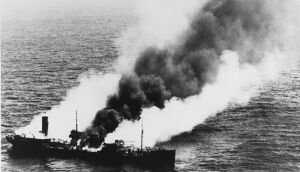
The results for Yves in 1935 were astounding, as by June 1st of 1935 over one hundred Capetian merchantmen and commercial freighters flagged as Capetian were sunk. The new method meant that the Cape was forced to create larger, slower convoys to maximize the amount of ships it could protect with its limited escort force, whilst the submarines of Group 2 slowly continued to sink them at an ever increasing pace. With the introduction of the HMAS Mercury, an HF transmissions and command ship that could sail in the Polynesian and bridge the gap between Group 2's patrol and raiding craft, the Arcer submarines would continue to mount losses against Capetian vessels for the remainder of 1936-1938, with the tonnage lost by the Capetian merchant marine and civilian freight companies began to outpace the ability of the existing fleet to sail or replace vessels with new ship laying.
Mid War (1938-1941)
Late War (1940-1943)
early war arco supremacy
mid war op lightfoot going on means subs pushed out further to polynesian for more effect
late war and lightfoot withdrawal means emphasis on at sea refuelling pays off and raiding is continued
dashing submarine raid near cape town or the eastern straits
HMAS superior destroyed lated war
Public Responses
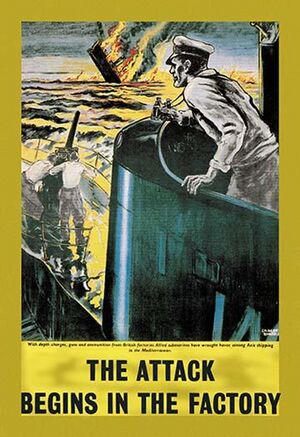
Arcerion
In Arcerion, the Army had traditionally been the dominant service in public media such as newspapers, films, and radio broadcasts. However until Operation Lightfoot, much of the war's reporting was centered around the actions and exploits of the Submarine Service, bringing it for the first time into the public eye. Popular fascination with this new means of warfare was combined with heroic tales of seafaring submariners and officers becoming daily topics of conversations in homes and pubs across Arcerion. Submariners and seamen of the silent service also would publish their records of patrols and their missions in the Arcerion Submarine Service Record, a gazette which reached an all-time high of two hundred thousand subscribers during the course of the war as Arcers across Crona and Howland wished to read of the tales and successes of their servicemen.
Post-war, a film would be made on the HMAS Something's exploits, as the most succesful submarine of the war. The film, titled 'Polynesian Patrol' Starring major film stars X, Y, and Z, it would become one of the first major Ixnay-wife successes in the Arcer film industry, and was a major cultural phenomenon. The Royal Arcerion Naval Service would later comment that the film's success and the sequel focusing on the exploits of the Navy during Operation Lightfoot were major assistants to the recruiting efforts they were making during the struggles the Armed Forces faced in the wake of the Second Great War.
The Cape
bad responses
negative press
pressure on govt to stop it
merchant marine riots over going to sea with no escort
Table for each year by tonnage and vessels sunk
2 subs and crew, include damage to other subs
See Also
Sumbarine service
arcer navy
operation Forefront
Existing Lore:
During the Second Great War Acer submarines saw extensive action against The Capetian Navy, operating in the Songun Sea and the Polynesian Sea. This was part of the larger Arcer naval mission to deny the Capetian Navy freedom of navigation and freedom of movement in the Songun sea, as well as conduct sea lane denial and commercial raiding to prevent the Cape from receiving the necessary materials and supplies it required to sustain its own war effort. Arcer submarines achieved the most success, as the Arcer surface fleet and Capetian Navy's capital ships never engaged directly in a major battle, the largest being a few smaller flotilla-sized actions between groups of escort ships that happened to make chance contact. Submarines operated under the umbrella mission of Operation Forefront, however under the command of Rear Admiral Lawrence Arthur Coxley, who was acting as Commander, Submarine Force, the Arcer Subsurface fleet operated under Operation Flyhook, which was the sea lane denial, commerce raiding, and minelaying conducted by the submarine force at this time.
Overall, Arcer submarines achieved great effect, sinking dozens of Capetian, Caphirian, and Daxian-flagged merchantmen, as well as a number of smaller Capetian warships of corvette and frigate-size. Moderate damage was done to Capetian major capital ships, although none were sunk, just forced into shipyards for repairs. During the war, four Arcer submarines were damaged by enemy fire or anti-submarine warfare, and an additional two were lost. His Majesty's Arcer Submarine Superior, was destroyed by enemy surface vessels, likely due to depth charges and being unable to surface in 1951. HMAS Typhoon was lost with all hands during an emergency dive rehearsal as part of crew training in the Malentine Sea, where it sunk to 300 meters and was destroyed. The legacy of the war continues to influence modern Arcer submarine doctrine. An emphasis on torpedo and mine warfare are consistently emphasized as the most important aspects of the Service's capabilities, and while it maintains the ability to launch cruise missiles and anti-ship missiles, these are considered of secondary nature.